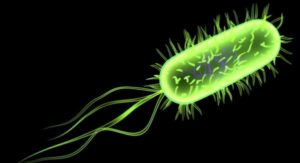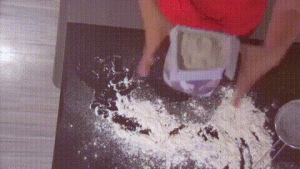In June, 2009, an outbreak of shiga-toxin producing E. coli (primarily O157:H7) in Nestle Toll House cookie dough sickened at least 77 people in 30 American states. Thirty-five people were hospitalized – from cookie dough.
 The researchers could not conclusively implicate flour as the E. coli source, but it remains the prime suspect. They pointed out that a single purchase of contaminated flour might have been used to manufacture multiple lots and varieties of dough over a period of time as suggested by the use-by dates on the contaminated product.
The researchers could not conclusively implicate flour as the E. coli source, but it remains the prime suspect. They pointed out that a single purchase of contaminated flour might have been used to manufacture multiple lots and varieties of dough over a period of time as suggested by the use-by dates on the contaminated product.
The study authors concluded that “foods containing raw flour should be considered as possible vehicles of infection of future outbreaks of STEC.”
So it wasn’t much of a surprise when 56 people fell sick from with the outbreak strain of E. coli O121 from Dec. 2015 to Sept. 2016 were linked to raw General Mills flour.
The peer-reviewed summary of the outbreak investigation was published last week in The New England Journal of Medicine.
Abstract below:
In 2016, a multijurisdictional team investigated an outbreak of Shiga toxin–producing Escherichia coli (STEC) serogroup O121 and O26 infections linked to contaminated flour from a large domestic producer.

Methods
A case was defined as infection with an outbreak strain in which illness onset was between December 21, 2015, and September 5, 2016. To identify exposures associated with the outbreak, outbreak cases were compared with non-STEC enteric illness cases, matched according to age group, sex, and state of residence. Products suspected to be related to the outbreak were collected for STEC testing, and a common point of contamination was sought. Whole-genome sequencing was performed on isolates from clinical and food samples.
Results
A total of 56 cases were identified in 24 states. Univariable exact conditional logistic-regression models of 22 matched sets showed that infection was significantly associated with the use of one brand of flour (odds ratio, 21.04; 95% confidence interval [CI], 4.69 to 94.37) and with tasting unbaked homemade dough or batter (odds ratio, 36.02; 95% CI, 4.63 to 280.17). Laboratory testing isolated the outbreak strains from flour samples, and whole-genome sequencing revealed that the isolates from clinical and food samples were closely related to one another genetically. Trace-back investigation identified a common flour-production facility.
Conclusions
This investigation implicated raw flour as the source of an outbreak of STEC infections. Although it is a low-moisture food, raw flour can be a vehicle for foodborne pathogens.
Shiga toxin–producing E. coli infections associated with flour
N Engl J Med 2017; 377:2036-2043, November 23, 2017, DOI: 10.1056/NEJMoa1615910
Samuel J. Crowe, Ph.D., M.P.H., Lyndsay Bottichio, M.P.H., Lauren N. Shade, B.S., Brooke M. Whitney, Ph.D., Nereida Corral, M.P.H., Beth Melius, M.N., M.P.H., Katherine D. Arends, M.P.H., Danielle Donovan, M.S., Jolianne Stone, M.P.H., Krisandra Allen, M.P.H., Jessica Rosner, M.P.H., Jennifer Beal, M.P.H., Laura Whitlock, M.P.H., Anna Blackstock, Ph.D., June Wetherington, M.S., Lisa A. Newberry, Ph.D., Morgan N. Schroeder, M.P.H., Darlene Wagner, Ph.D., Eija Trees, D.V.M., Ph.D., Stelios Viazis, Ph.D., Matthew E. Wise, M.P.H., Ph.D., and Karen P. Neil, M.D., M.S.P.H.
http://www.nejm.org/doi/full/10.1056/NEJMoa1615910
 A public health advisory will be issued for outbreak investigations
A public health advisory will be issued for outbreak investigations











